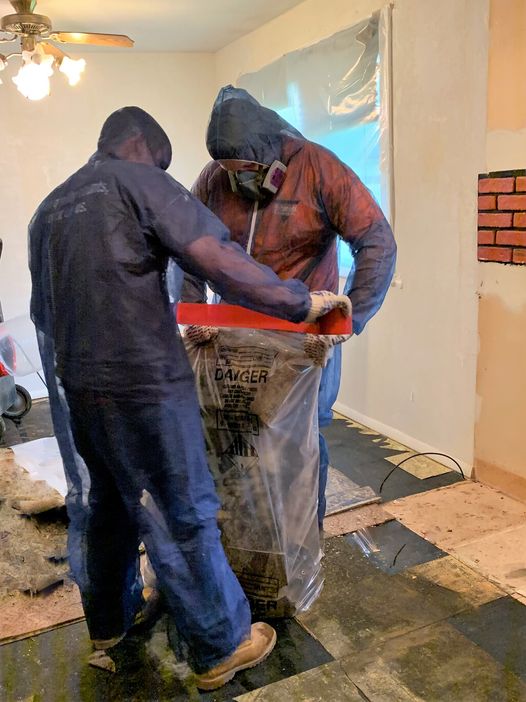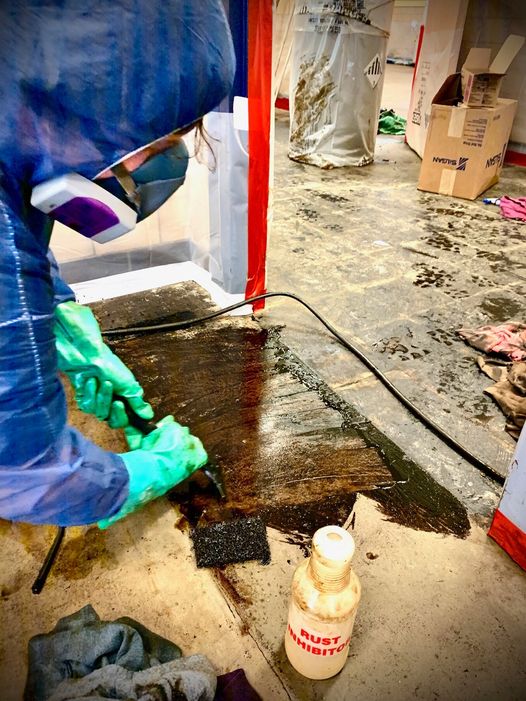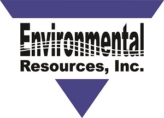Licensed & Certified Asbestos Abatement Company Serving Wood River IL
The Wood River IL asbestos removal experts at Environmental Resources, Inc. provide quality and safe asbestos abatement services for a wide variety of commercial and industrial buildings. Our staff is trained, certified, licensed and experienced in any sized Wood River IL area asbestos removal project. We have experience in the removal of asbestos containing materials such as: floor tile, mastic, ceiling tile, plaster, window caulk, Transite siding, drywall, linoleum, pipe insulation, duct wrap, duct tape among others.
Our attention to detail and superior customer service make us the best choice for any asbestos removal project in Wood River IL. ERI communicates thoroughly with our clients to discuss concerns and expectations for any sized project and strives to ensure that customers are always kept in the loop while work is in progress.
Dealing with the potential hazardous that asbestos can cause is not only disruptive of day to day living but can also be a serious health concern to those who may be exposed to it on a frequent basis. We pride ourselves in using the best and safest techniques for asbestos removal and disposal so that our Wood River IL area customers are ensured a safe environment both during removal and after work has been completed.
Call Environmental Resources, Inc. at (618) 471-9119 to schedule an inspection and we’ll be able to suggest a plan of action.
REQUEST A FREE ESTIMATE
Is Asbestos in your Wood River IL building?
Although asbestos may be present in many locations in your home, its mere presence does not necessarily pose a hazard. You should be aware of the locations of materials and equipment that could possibly contain asbestos in order to decide if and when action is appropriate.
Where Asbestos May Reside
Exterior Surfaces
Wall and closed-deck undersheeting, cement-asbestos-board (CAB) siding and panels, roofing felts, shingles, and even window putty may contain asbestos. In general these materials do not constitute a hazard if they are left in place and are undamaged. If these materials are damaged or are to be removed, drilled, sanded or cut they may release asbestos fibers.
Automobile-Related Materials
Brakes and clutches often contain asbestos. As clutch facing, brake shoe, and brake pad materials wear down in normal use, asbestos-containing dust is created. Ideally, work on clutches and brakes should only be done by professionals where specialized vacuum and protective equipment is available. Home repair of clutches and brakes can be hazardous to both the mechanic and the rest of the household. Never blow on, use a vacuum cleaner, or use an air hose to clean these areas.


Insulation
Loose fill (e.g. vermiculite), blown-in and batt insulation infrequently have been known to contain asbestos. These are generally not a hazard if left in place undisturbed. However, any remodeling or demolition which disturbs asbestos-containing material can create a hazard.
Floorcoverings
Sheet vinyl (including the backing or underlayment), vinyl tile, and tile adhesive may contain asbestos. If remodeling, sometimes it is best to cover over the old flooring. In no case should you grind down or sand the floor surfacing or the adhesive residue remaining on the floor.
Boilers, Heaters & Piping
- Furnaces & Boilers – Insulation blankets (outside covering), door gaskets, duct insulation, and tape at duct connections all may contain asbestos.
- Pipe Wrapping – Steam or hot water pipes, especially in older homes, may have asbestos in the covering insulation, particularly at elbows, tees and valves.
- Wood Stoves – Older model stoves may have asbestos in door gaskets and in the cement-asbestos-board (CAB) placed under and/or behind the stove.
Interior Surfaces: Walls & Ceilings
Wall surfaces of older homes may be constructed of asbestos-containing materials. If left undisturbed these would not create a hazard. Prior to 1978, asbestos was sometimes used in sprayed-on or troweled-on textured ceilings and walls. If the material is firmly attached and has a hard surface it is not hazardous. If the surface can produce powder or dust by hand pressure or as a result of water damage, it is advisable to seek professional advice before deciding what course of action to take.
Some older attached or suspended ceiling tiles contain asbestos. If they are not damaged by water and are not being cut, drilled, or sanded; they do not constitute a hazard.
Electrical Equipment
Older lamp socket collars, electric boxes, liners for recessed lighting, and old fashioned wiring insulation has been found to contain asbestos; normal use of these items should not pose a hazard. Replacement products in these categories do not contain asbestos.
Built-in Equipment
Oven & dishwasher (in cabinet) units were often wrapped in asbestos-containing insulation blankets or sheets until the mid-1970’s. Homeowners should not disturb these materials; they will not pose a hazard if left in place. Removal or repair should be done by professionals, and the materials or the entire unit should be discarded in an approved manner.
Appliances
Portable dishwashers, toasters, clothes dryers, and slow cookers all have had parts made with asbestos-containing materials which could give off fibers when the appliance is being repaired or disassembled. The use of asbestos in these appliances is declining and newer purchases may have none. Consider discarding these items in an approved manner instead of repairing them.
Some older hair dryers and portable heaters may still be in use where the coil-wrapping and insulation contain asbestos; these dryers and heaters should be discarded.
Freezers and water heaters (in some older models) may have asbestos in the insulating blanket within the metal cover. It poses no hazard in normal use. When an appliance requires replacement, dispose of it without disassembling and discard it in an approved manner.
Miscellaneous
In rare cases, packaged cat box litter/deodorant has been known to contain some asbestos. Older gas-fired decorative fireplace logs and artificial ash may have a considerable amount of asbestos fibers and if disposed of should be handled in the same manner as other asbestos materials. Asbestos-containing gloves, stove-top trivets, and pads that are still being used should be discarded in an approved manner.
Asbestos Removal and Abatement FAQs
What exactly is Asbestos and why is it in my home or business?
Asbestos is a manufactured material designed for its flame-retardant and insulating properties made and used from the 1940s to the 1970s. Because of its usefulness as an insulator in daily life, it was heavily utilized in buildings and home during the period when it was popular. In fact, most structures built or lived or worked in during this time probably contained components containing asbestos. In short, it’s frequently found in the places where we live and work.
Homes and businesses in the Wood River IL area and in the metro east are no exception to the common applications of asbestos in living and work spaces. Asbestos was found to be effective, cheap and durable and therefore it was used widely in homes and buildings.
Is asbestos exposure dangerous?
Yes and no. As we already noted, asbestos is found all around us. When asbestos materials are found as they were designed, when they are undisturbed, undamaged and otherwise intact, they pose little health thread. However, when they are in a highly-trafficked area, when they are damaged (for instance, if they suffer water damage, if they are disturbed through use or remodeling or when they are worn (as in asbestos tiles that are in high traffic areas) they can produce asbestos dust.
Because asbestos is found in residential and commercial areas they are often in areas of high traffic, and because of this, an asbestos dust containing microscopic and dangerous asbestos fibers can be released into the air that people are breathing.
As mentioned above, when asbestos is damaged or is allowed to create dust it becomes a danger. And the very nature of dust, that it is easily transported and spread through movement and even through the air as asbestos dust particles makes it most dangerous. The fact that dust particles are easily breathed and ingested means that asbestos can be introduced to the internal organs of an individual or family and it is because of this that asbestos poses a danger as a cancer-causing element – or carcinogen.
When asbestos is allowed to break down into asbestos dust it becomes dangerous. Normal human activities can cause this break down. Simple movement or activity that comes in contact with asbestos can cause it to become dust. But, if you are considering home improvement or building remodeling projects you raise the danger of disturbing asbestos and creating dust. Perhaps ironically, even the activity of improperly removing asbestos, and thus disturbing it as it is separated from a structure and transported out of a building, can be the most likely activity to cause the dangerous dust to be produced and spread.
I just found asbestos in my house, what should I do?
As noted earlier, asbestos is commonly found in the home or other buildings. Finding asbestos is not at all uncommon. The question becomes one of determining whether or not the asbestos is in an area or in such a condition where it should be left alone or removed.
You might be able to make this determination on your own or you might want to call in an environmental service expert to get their opinion. If you determine that the asbestos could pose a problem you should then call an asbestos removal service so that the hazardous materials are encapsulated and carefully removed in such a way that they do not produce or spread any hazardous asbestos dust into other areas of the structure. This last point summarizes why it is important to call a trusted asbestos removal or asbestos abatement professional such as Environmental Resources, Inc.
What is asbestos remediation?
Asbestos remediation or removal is the process of using approved, best practice techniques for containing, removing and safely eliminating asbestos from the home or from structures frequented by people.
It is important to note that the act of removing the potentially hazardous asbestos can exacerbate the danger that the material itself poses. This is why it is important to get an informed recommendation from an experienced asbestos professional to decide the plan for going forward.
How much does asbestos remediation cost?
Asbestos removal and asbestos remediation prices can vary depending upon how involved the removal process is. This is why it is always important to get a professional opinion on your asbestos situation as soon as you become aware of it.
Some instances of asbestos in the home or business structure will require no attention. For instance, if asbestos is present in areas of the structure where there is nothing to disturb them, such as in areas that have been isolated from traffic and weather, it is often not necessary to consider any action. However, if asbestos is in danger of wearing or breaking down due to weather or other disturbing factors, removal should be considered.
Environmental Resources, Inc. has remediated asbestos in residential settings that have cost only a few hundred dollars, to commercial settings costing upwards of a hundred thousand dollars. No job is too big or small for us!
How long does the asbestos removal process take?
The amount of time allotted for asbestos removal varies just as the cost and circumstances surrounding the asbestos in the home or business vary. If asbestos has been allowed to break down, degrade or spread in damage over time its removal can be more involved and thus take longer. This is why it is important to get an asbestos inspection and recommendations as soon as asbestos is discovered.
Do I need to hire an asbestos removal company, or can I do it myself?
While homeowners are legally allowed to treat an asbestos problem on their on (business owners are not), it is not recommended. Consider the downside of doing it yourself. By its very nature asbestos dust is easy to create, spread and inhale. A bad attempt at asbestos removal can create a situation where the danger to people rises dramatically.
Plus, Environmental Resources, Inc. can give you the peace of mind to be confident that all the asbestos that needs to be removed has been removed from your problem areas.
Are you certified to remove asbestos?
Environmental Resources, Inc. has been safely removing asbestos in the Wood River IL area for almost three decades. Our staff is trained, certified, licensed and experienced for any size asbestos removal project.
Will you test my house for asbestos?
Call Environmental Resources, Inc. at (618) 471-9119. We will discuss your concerns with you and schedule a free asbestos evaluation to determine the nature of your asbestos problem and to help you understand what should be done about it. We’ll be able to answer your asbestos questions in greater depth and with greater accuracy upon inspecting the asbestos in your home or facility.
We’ll also be able to point out concerns in such a way that you will be able to understand and make a more informed decision about your asbestos abatement situation.

